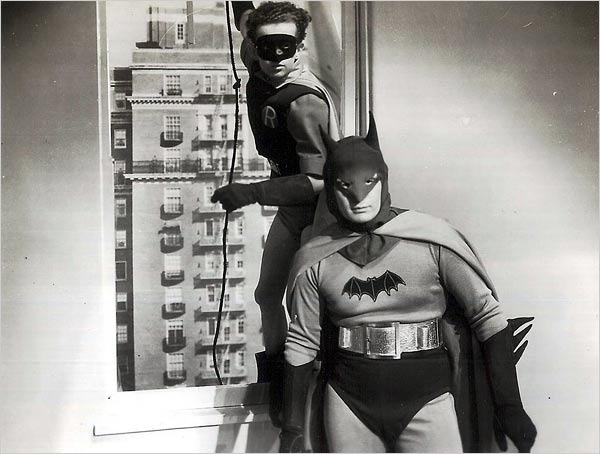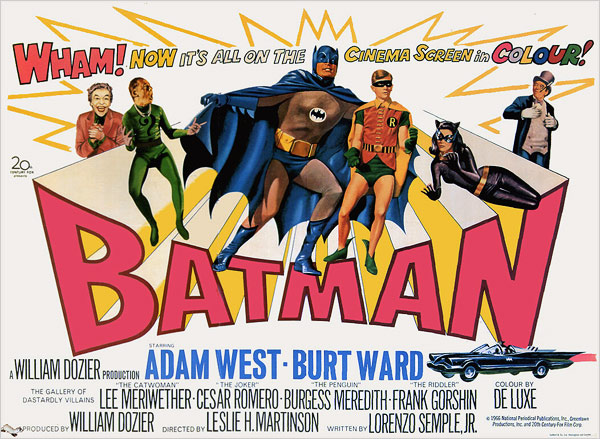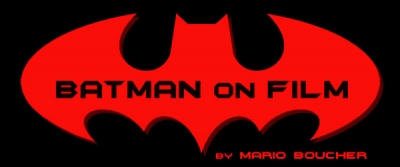Over the past 70 years, Batman's adventures on the screen have fascinated people of all ages. From Lewis Wilson to Christian Bale, seven men have worn the cape and cowl of the famous detective as created by Bob Kane and Bill Finger in the 1930's. Many writers and directors have put their stamp on the world of Gotham City on the big screen and on television.
Batman on film began in serial style in 1943 (in The Batman). Wilson was the first actor to don the cape fighting Dr. Daka (J Carrol Naish) with the help of Robin (Douglas Croft) in an adventure that includes a death ray and some zombies. Humble beginnings for the Dark Knight.

The very first shot of Batman shows him sitting at his desk, leaning his chin on his hands in the Batcave and waiting to go into action. He leaves through the secret entrance via the grandfather's clock inside Wayne Manor, a tradition that would be part of all subsequent movie versions.
Alfred Pennyworth was portrayed in the comic books at the time as overweight but is tall, thin and has a mustache in the serials. The comic books adopted the changes forever transforming Alfred in print and on screen.
As directed by Lambert Hillyer, the first Batman movie has decent action scenes for its time. Sure, Batman has to use some kind of public phone to call the Commissioner, all in broad daylight, but the 15-part serial is entertaining in its own goofy way.
A second serial was released in 1949 with Robert Lowery taking over as Batman and John Duncan as Robin battling the Wizard (Leonard Penn), a villain who can become invisible. Among the interesting anecdotes from Batman and Robin are the appearances of Vicki Vale (Jane Adams) and the Bat-Signal in broad daylight.

These two serial movies may be not hold well but they reflect the times during which they were made and remain an interesting look at the beginnings of Batman on the big screen.
When Batman finally returned to the screen, it would be far removed from his original concept. Played for laughs, the Batman of the 1966 movie and the subsequent TV series (1966-68) was overweight, slow and smiled a lot. It was sometimes difficult to see a difference between the laughing Joker and the smiling Batman. Adam West obviously had fun in the title role alongside many great character actors playing the various villains. The TV series was shown twice a week with the first episode ending on a cliffhanger.

It would take another two decades for a more definitive Batman movie to be made. During the 1960's through the 1980's, Batman appeared in animation on television from Batman/Superman Hour (1968-69) to SuperFriends (1972-1986). The shows were obviously aimed at young kids and featured silly plots. Heck, Batman even solved mysteries with Scooby-Doo (1972). It would all change, live action and animation beginning in 1989.
When Tim Burton's Batman opened in June of '89, the first images were of two thugs encountering a giant bat creature on a rooftop. As they look up, huge wings opened wide and there stood the Batman. "What are you?" "I'm Batman." It was unlike anything seen before in the world of the Dark Knight.
The movie has some flaws but it did bring darkness to Gotham City. The atmosphere created by Burton and Anton Furst, production designer, redefined what Batman could be on the screen.
The lead character as played by Michael Keaton is treated seriously instead of played for laughs. He's even a little loopy. "C'mon, you wanna get nuts, let's get nuts," screams Bruce Wayne to Jack Napier, aka The Joker. In fact, it remains arguably the craziest scene involving Bruce Wayne to this day.
Jack Nicholson plays the Joker to the hilt and overshadows the hero; therein lies some of the problems with the original movie. The villain takes over the movie, occupying much of the screen time, and is too potent for the hero. The story is quite basic with some of the decisions looking bad in retrospect, especially the idea that one stupid gun could take down the Batplane. Kim Basinger screaming and screaming doesn't help either. There are too many scenes that stop the movie dead, particularly the long parade involving the Joker.

Yet, the '89 Batman remains a good movie overall with a nice mix of character moments and action. Given the technology at the time, some action sequences were well done such as Batman flying through the museum. The fight sequence between Batman and Joker's thugs following the escape from the museum is still pretty good. Keaton and Michael Gough as Alfred create a believable relationship. We see a little detective work when Wayne reads over Napier's file and puts together that the Joker knows much about chemistry and is behind the plot against Gotham City. And there is a great sequence in which Batman drives back to the Batcave with Vicky Vale to the rousing score of Danny Elfman, excellent from beginning to end.




